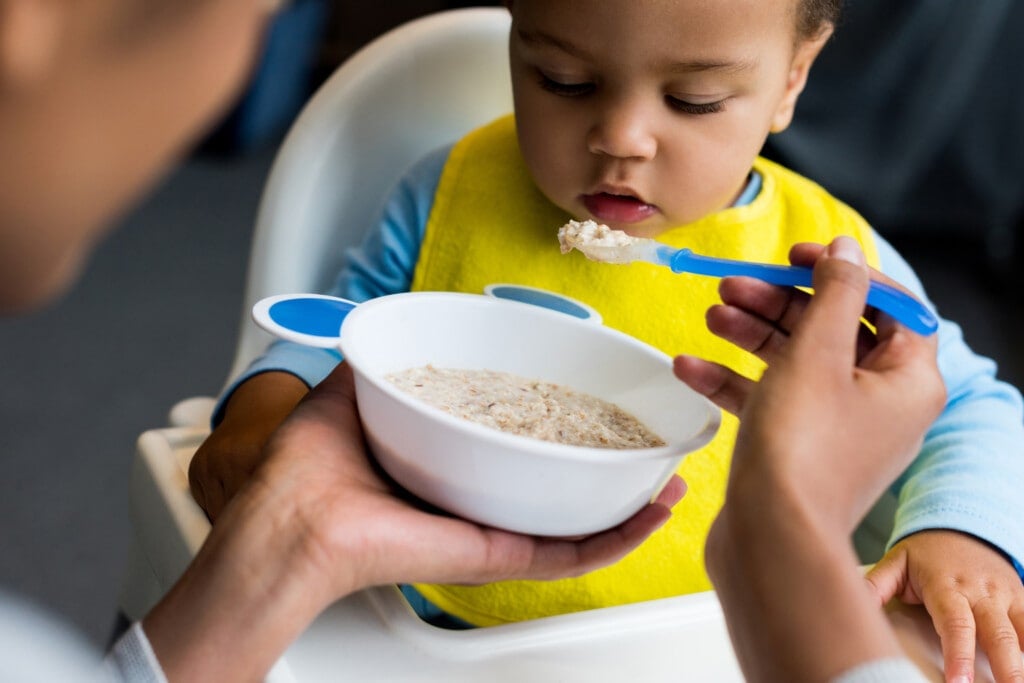Imagine you have recently determined that your little one is showing signs of being ready to start solids. You are gearing up to jump into this new and thrilling stage together. While you understand that your child’s primary source of nutrition will continue to be breast milk and/or formula for some time, you know that introducing solids is an important milestone nonetheless. Now, you wonder where to begin. What foods should you offer, and what consistency should they be? How much do you give and how often? Are there any foods that you should limit or avoid altogether?
Why You Should Avoid Rice Cereal
There are countless questions about children’s early nutrition, many of which are covered in this article. As more research is done, newfound knowledge allows us to create evidence-based guidelines for what pediatricians recommend to parents. It also helps direct changes we need to take away from current practice. A prime example of this is when research demonstrated concerning levels of arsenic found in rice cereal and the subsequent adjustments to intake guidance that followed.1
Concerning Levels of Arsenic
Arsenic is a natural element of the Earth’s crust found in water, air, and soil. It often pollutes fields where rice is grown, and rice absorbs it more than most other grains. Interestingly, more arsenic is found in brown rice than white rice due to arsenic accumulating in rice bran. This is most likely related to high levels of all these metals in our air, water, and soil — related to runoff or pollution from chemicals used in manufacturing and farming around the United States and worldwide.
According to the U.S. Environmental Protection Agency (EPA), inorganic arsenic is a known human carcinogen, which means it is linked to cancers, specifically of the skin, lung, liver, kidney, and bladder.2 It also poses risks to a child’s developing brain. Inorganic arsenic exposure could decrease a child’s performance on certain developmental tests that measure learning, based on epidemiological evidence, including dietary exposures. It’s toxic for everyone, but babies are more vulnerable than adults.
Use Caution and Limit Exposure
This is concerning information but is likely not a new problem or a problem limited to one brand. We have known that arsenic is leached from the soil, causing elevated levels in rice cereal. These metals are in the foods, likely not the processing. So it’s likely the same if you eat the foods, mash, purée, or jars of purée. We have multiple dietary sources of arsenic and other heavy metals, so it is something to pay attention to. And it is worth exploring from an agricultural perspective to ensure good practices. When nearly half of all infant rice cereals were found to be near the limit in 2016, the FDA proposed an “action level” of 100 parts per billion (ppb) for inorganic arsenic. This limit was finalized in August 2020.3
This is one reason why many of us who care about children are intent on having strong environmental regulations and policies to protect our children. There is no reason to test for heavy metals in your child at this time. But you can take measures to decrease consumption and help limit this exposure. This is a “do the best you can within reason” scenario, like so much of parenting.
What To Offer Your Baby Instead
I encourage families to focus on variety and not a lot of volume when introducing new foods. If your child is eating infant cereals, offering an assortment of grains, including oat, barley, and multi-grain, is important instead of only rice cereal. More variety of foods means less potential for exposure to high heavy metals.
For the lowest levels, use basmati rice grown in California, India, and Pakistan. According to testing by Consumer Reports, Rice from Arkansas, Louisiana, or Texas has the highest levels. Cooking brown rice in excess water (six to 10 parts water to one part rice) and draining the excess water can reduce the arsenic content by as much as 40%. Watch for rice syrup as a sweetener. It can contain elevated arsenic. Avoid processed foods containing brown rice sweeteners. Do not use rice milk as a primary milk alternative.
If your child has a swallowing disorder (dysphagia) or gastroesophageal reflux disease and needs cereal thickeners added to formula or breastmilk, the AAP suggests using oatmeal instead of rice cereal.4 Unless explicitly instructed by your child’s pediatrician or a feeding specialist, it is recommended that caregivers NOT put baby cereal in a bottle. Doing this could cause your baby to choke and may also increase the amount of food they eat and can cause them to gain too much weight.
Know Better, Do Better
If rice has been a staple food for your child leading up to today, do not panic. Many bright, developmentally appropriate, healthy people have been eating rice for years and have been fine. I intend not to instill fear but to spread awareness and share this information with you. As the saying goes, when you know better, you can do better. There is no changing the past. Instead, limit this exposure and offer your child a healthy, balanced diet.



































